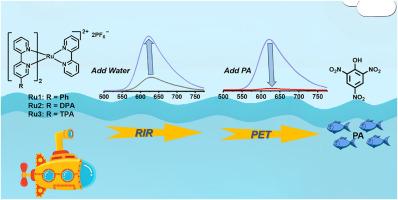AIPE-active cationic Ru(II) complexes for detecting picric acid in aqueous media
IF 4.2
3区 工程技术
Q2 CHEMISTRY, APPLIED
引用次数: 0
Abstract
Three cationic Ru(II) complexes, Ru1–Ru3, were designed and synthesized by introducing a phenyl (Ph), diphenylamino (DPA), and 4-(diphenylamino)phenyl (TPA) group to two 2,2′-bipyridine ligands, respectively. All complexes were fully characterized. Ru1–Ru3 exhibit aggregation-induced phosphorescent emission (AIPE) properties in THF/H2O. Ru1 containing the Ph group and Ru2 containing the DPA group exhibit maximum emission intensity at a 70% water fraction, showing 2.25-fold and 2.28-fold enhancement compared to those in THF, respectively. Notably, Ru3 incorporating the TPA group demonstrates the highest AIPE activity. The emission intensity of Ru3 in THF/H2O at a 90% water fraction increases to 4.01-fold of that in THF solution. Utilizing the AIPE properties of Ru1–Ru3, the detection of picric acid (PA) in aqueous media was successfully achieved. Moreover, Ru1–Ru3 exhibit highly selective and sensitive detection of PA even in the presence of various interfering substances, including nitroaromatic, phenolic, and ionic compounds. Among them, Ru3 possesses the highest sensitivity (KSV = 9.4 × 104 M−1) and the lowest limit of detection (LOD = 23 nM). The mechanism of Ru1–Ru3 as the probes for detecting PA is photoinduced electron transfer.

aipe活性阳离子Ru(II)配合物在水中检测苦味酸
通过在两个2,2 ' -联吡啶配体上分别引入苯基(Ph)、二苯胺(DPA)和4-(二苯胺)苯基(TPA),设计并合成了三个阳离子Ru(II)配合物Ru1-Ru3。所有配合物都得到了充分的表征。Ru1-Ru3在THF/H2O中表现出聚集诱导磷光发射(AIPE)特性。含有Ph基团的Ru1和含有DPA基团的Ru2在70%水分数时的发射强度最大,分别比THF增强2.25倍和2.28倍。值得注意的是,加入TPA组的Ru3表现出最高的AIPE活性。水分数为90%时,钌在THF/H2O中的发射强度是在THF溶液中的4.01倍。利用Ru1-Ru3的AIPE特性,成功地实现了水介质中苦味酸(PA)的检测。此外,Ru1-Ru3即使在各种干扰物质(包括硝基芳香族、酚类和离子化合物)存在的情况下,也表现出对PA的高选择性和灵敏度检测。其中,Ru3的灵敏度最高(KSV = 9.4 × 104 M−1),检出限最低(LOD = 23 nM)。Ru1-Ru3作为探针检测PA的机理是光诱导电子转移。
本文章由计算机程序翻译,如有差异,请以英文原文为准。
求助全文
约1分钟内获得全文
求助全文
来源期刊

Dyes and Pigments
工程技术-材料科学:纺织
CiteScore
8.20
自引率
13.30%
发文量
933
审稿时长
33 days
期刊介绍:
Dyes and Pigments covers the scientific and technical aspects of the chemistry and physics of dyes, pigments and their intermediates. Emphasis is placed on the properties of the colouring matters themselves rather than on their applications or the system in which they may be applied.
Thus the journal accepts research and review papers on the synthesis of dyes, pigments and intermediates, their physical or chemical properties, e.g. spectroscopic, surface, solution or solid state characteristics, the physical aspects of their preparation, e.g. precipitation, nucleation and growth, crystal formation, liquid crystalline characteristics, their photochemical, ecological or biological properties and the relationship between colour and chemical constitution. However, papers are considered which deal with the more fundamental aspects of colourant application and of the interactions of colourants with substrates or media.
The journal will interest a wide variety of workers in a range of disciplines whose work involves dyes, pigments and their intermediates, and provides a platform for investigators with common interests but diverse fields of activity such as cosmetics, reprographics, dye and pigment synthesis, medical research, polymers, etc.
 求助内容:
求助内容: 应助结果提醒方式:
应助结果提醒方式:


